How to Create a Team to Be Proud of
Before we get into the definition of team building skills, first some background.
Various studies have shown how team development significantly improves organisational performance. Furthermore, team empowerment not only improves the organisation process but also enhances customer satisfaction.
Now for such great benefits, does it require massive investment?
Not necessarily.
Twitter set up a team-oriented environment with rooftop meetings and friendly co-workers. The result? Twitter’s employees ranked as the happiest in the United States, and they ceaselessly raved about the company’s culture.
This in-depth guide will help you create a highly motivated, team-oriented environment, just like Twitter. And even more, providing great team-building mentoring and coaching skills for managers & supervisors.

This Ultimate Guide will Cover:
- What are Team Building Skills?
- What is the Purpose of Team Building?
- Team Building Exercises and Activities
- Where to Apply Skills in Team Building
- How Team Building Affects Performance
- Team Building Skills in the Workplace
- How Team Building Skills Work
- Eduardo Salas’ Four Approaches to Team Building Teamwork Skills
- Bruce Tuckman’s Forming Storming Norming Performing Team-Development Model
- Challenges to Team Building
- 8 Mistakes to Avoid in Team Building
- Evaluating Team Building Skills Effectiveness
- Further Reading and Resources
1) What are Team Building Skills?
Team Building Skills Definition: the use of collaborative tasks to enhance social relations and define roles in teams. Now this is different from team training. This is because the latter focuses on improving team efficiency – not the interpersonal skill of team building.
The definition of team building skills extends beyond this and as you read on you will gain an even greater insight into soft skills of team building. Of all group-development activities, team-building activities are among the most critical in any organisation. And this is for good reasons too, as we’ve hinted above with Twitter.
2) What is the Purpose of Team Building?
Now that the definition of team building skills has been formulated, we must ask what purpose is served. By exposing and addressing interpersonal problems within groups, skills in team building aim to improve performance in team-based environments.
Generally, team-building exercises achieve four key goals:
- Aligning the team around specific goals.
- Reducing ambiguity concerning team members’ roles.
- Building effective working relationships.
- Finding solutions to problems in teams.
3) Team Building Skills Activities
There are many different types of team cultivation skills activities. And they range from things like simple games for communication skills played in the office to adventurous retreats. Nevertheless, the underlying purpose of any team-building is to help employees strengthen relationships, develop skills, and escape the norm. All in all, it’s about building team skills.
Team building activities in communication skills are the most preferred styles of exercises to practice within your team.
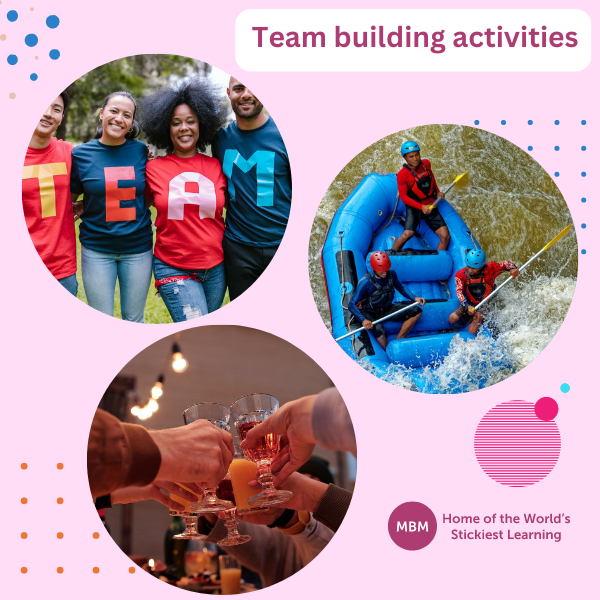
The Five Most Effective Team Building Skills Activities Are:
- Volunteering
- Physical activities
- Field trips
- Professional development activities
- Shared meals
4) Where to Apply These Skills
As a foundation of an organisation, team-building skills are a vital tool for any group of individuals. See the below list:
#1- Schools
Study or project teams in learning institutions perform better with effective teamwork skills. In particular, teachers and other staff members benefit from cohesive team-building skills.
#2- Organisations
Workers produce better results through collaborative team-building activities. And consequently, employee engagement leads to meaningful and valuable creative solutions for individuals, the team and the company. And it helps with staff retention too.
To illustrate, SquareSpace is a splendid example of a company that exhibits an all-around team effort derived from its flat organisation structure (no, or very few, levels of management between staff and executives). Even more, it’s often voted as one of the best places to work in New York City.
#3- Sports
Individuals with unique skills make up a sports team, but they are all interdependent. And they must coordinate and orchestrate to blend their varied skills and achieve a unified goal. This, therefore, requires cohesive teamwork skills.
In addition, sports team-building skills also emphasise team identity by instilling a sense of shared destiny. Team building games for communication skills are also an imperative part of sport and these skills are transferrable.
#4- Military Units or Flight Crews
The military, for example, requires sober leadership skills, cohesive skills in team building, expert planning and sound decision-making in challenging and rapidly changing environments. In particular, team support is vital within the extremely volatile environments in which soldiers operate. For further information, read our extracts of Sun Tzu’s ‘Art of War’ on the benefits of team-building skills.
#5- How they Affect Performance
Googlers—Google staff—are widely regarded as the best of the best. That is because they are highly driven and talented workers. Consequently, the company is the second most valued in the world with a brand value of $101.8 billion, according to Forbes.
But that didn’t happen by accident.
Indeed, Google continually invests in building a highly motivated and cooperative team. And some of the perks of working at Google include free meals, parties and employee trips. They also offer gyms, a dog-friendly environment, financial bonuses and open presentations by high-level executives.
Also, numerous studies show how highly motivated and cohesive teams produce top organisational performance.
Group cohesion is vital for a motivated workforce, based on a Harvard Business School publication. Also, research from the American Psychological Association (APA) shows how activities to develop team-building skills make employees feel valued, which motivates them to excel at work.
Indeed, building team skills isn’t merely a feel-good exercise.
But only properly organised skills in team building are effective. It should involve knowledgeable, experienced and interdependent team members, complemented by active support from the organisational leadership. Also, the teams must be aware of and work towards specific goals apart from having clear roles and procedures.
6) Team Building Skills in the Workplace
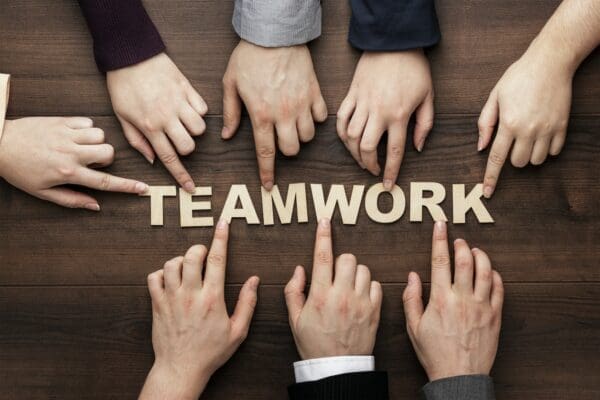
Philadelphia’s Pennsylvania Hospital (support services division) is a notable example of an organisation which implemented a team-based facilities group to improve its performance. This involved five significant elements, which are the core of team-building skills.
Team Building Skills List:
- Implementing a team-based organisation
- Establishing individual performance standards
- Developing team performance goals and objectives
- Individual staff development and
- A recognition program
Research also shows that specific components of team-building skills produce more exceptional organisational performance. Thus this team-building skills list does not exist in the abstract as the performance of any organisation can be greatly improved.
A 1999 study by researchers from Syracuse University identified role clarification as likely to increase organisational performance. Indeed, this is more than other components of team-building skills. Specifically, this includes goal setting, problem-solving, and the interpersonal skill of team building relations.
Indeed, that makes sense, since, without clear roles, you can’t properly delegate responsibilities to the right people, preventing effective people management. In turn, this affects problem-solving, interpersonal relations and goal-setting.
Skills in team building are beneficial to multiple types of organisations and work environments. For example, a study by the University of Maryland evaluated the impact of teams on flight crews, computer-supported groups and other types of autonomous workgroups. Not surprisingly, the reviews found overwhelming evidence of the contribution of teams to organisational effectiveness.
In short, team-building skills are an excellent asset to any organisation and team-building games for communication skills can really improve a particular organisation as a whole.
Excuse the Interruption, but Here’s a Little Bit About Us…
We are the soft skills training provider to the UK Grocery Industry, helping Suppliers to win more business. They choose us because of our money-back guarantee, our relevant experience, and because we make their learning stick.

7) How Skills for Team Building Work
There are several different theoretical approaches used for developing team-building skills. But the two notable ones are Eduardo Salas’ Four Approaches to soft skill team building and Bruce Tuckman’s Forming Storming Norming Performing team-development model.
For more help, visit our team-building skills training page.
8) Eduardo Salas’ Four Approaches to Team Building Skills
In the ‘Handbook of Human Factors and Ergonomics Methods’, Eduardo Salas and colleagues’ explained four approaches to team-building skills:

#1- Setting Goals
Teams require clear objectives for both individuals and the whole team.
In a collaborative effort, team members plan, identify and define success and failure based on the team goals. This way, everyone has a sense of ownership, since they are part of it from the start. Also, this strengthens motivation.
With clear goals, it’s possible to identify specific outcomes and measure the team’s progress.
REI, a camping and outdoor product company, is an example of an organisation with clearly defined team-building goals. And its mission – to equip both customers and employees for the outdoors – is a key objective of its team cultivation skills activities. Uniquely, employees are enticed with ‘challenge grants’ where they submit proposals for challenging outdoor adventures to win equipment.
#2- Role Clarification
Members must understand their roles and duties, as well as other team members’ roles and duties.
Such role clarification reduces ambiguity and fosters an organised structure for a well-coordinated team effort. As members focus on their unique roles, they are also aware of their interdependence within the team.
#3- Problem-solving
Teams are primarily set up for a purpose. In particular, they need to identify and work together to solve key problems.
By and large, proper role clarification will enhance problem-solving. In particular, large problems are broken down into manageable sections and different tasks are handled by appropriately competent individuals.
This is evident in Philip Krim and his friends’ (Gabriel Flateman, T. Luke Sherwin and Jeff Chapin) approach to solving the problem of setting up Casper, a mattress firm. They each applied their unique skills to solve different parts of the problem. Specifically, Krim, the mattress expert, dealt with product design. Sherwin who knew how to build a brand focused on doing that. Flateman, a web designer, took charge of the company’s online presence. Lastly, Chapin took the role of the stylist.
#4- Interpersonal Relations
Interpersonal skills team building relations include communication skills, sharing, and giving and receiving support.
Excellent interpersonal relations are vital in developing mutual trust between team members and avoiding conflicts. A facilitator guides and influences the conversation towards mutual trust and away from conflict. This, therefore, ensures an effectively functioning team.
A company like Warby Parker, which designs prescription glasses and sells directly to customers, applies creative interpersonal skills for team building. For instance, random employees are sent out to lunch together, and the firm insists everyone helps keep break areas clean.
Such strategies create situations of close interaction with other employees, where they can communicate and share.
9) Bruce Tuckman’s Team-Development Model
Published in 1965, Dr Bruce Tuckman’s model, Forming Storming Norming Performing, gives a systematic explanation of the progression of team development behaviour.
All in all, Tuckman’s model shows how gradually more authority and freedom move to the team while the leader’s control reduces. As the team matures, its ability increases, relationships are established and, consequently, the leadership style changes.
1st Stage – Forming
Characteristics
At this initial stage, team members are highly dependent on the leader for guidance and direction. Members aren’t sure of their roles and responsibilities, and they have little agreement on the team’s aims.
Challenges
Due to a lack of clarity, members often ignore processes. They also test the system and the leader’s tolerance.
Leadership Style
The leader directs. Such a leader will be relied on to explain the team’s purpose, objectives and external relationships.
Also, tested and proven team cultivation skills for work can help build cohesion.
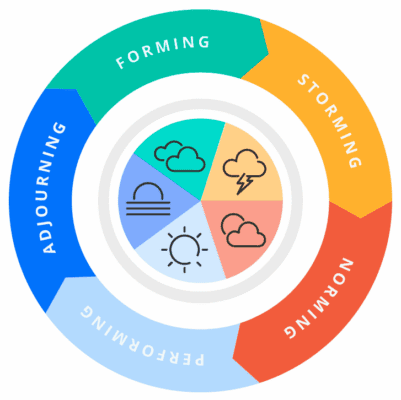
Image courtesy of Wikipedia.
2nd Stage – Storming
Characteristics
Here, there’s still plenty of uncertainty, but members get a clearer understanding of the team’s purpose. They also try to establish themselves by vying for positions.
Challenges
The leader might receive challenges as members seek to establish themselves in relation to the leader or other members. In such an environment, decisions can’t come easily. The situation also creates cliques and factions, which inevitably lead to power struggles.
Leadership Style
The leader coaches. The team must arrive at a compromise for it to progress. The leader should also help the team focus on its goal and avoid relationship and emotional distractions.
Communication is key to building team skills and maintaining the team. It can be particularly challenging with teams in different locations. To overcome this, Baggu, for example, used technology and a dedicated company ‘liaison’ to maintain open lines of communication between its West Coast-based design and operations team and the New York-based sales team.
3rd Stage – Norming
Characteristics
Here, the team now responds well to its leader’s facilitation, and they clearly understand and accept their roles and responsibilities. Here, group agreement precedes big decisions, while smaller decisions come from individuals or smaller groups within the team. Also, the team discuss and develop processes and working style.
Advantages
There are extensive agreement and consensus among the members. They have a strong commitment and unity and may engage in fun and social group activities.
Leadership Style
The leader facilitates and enables the team. Some of the leadership is even shared by team members, with the leader having general respect from the team.
At this point, the maturing team possesses greater autonomy.
For instance, Adobe is one company that shows the value of greater autonomy for its workforce. The managers serve as coaches, and they even go as far as letting employees set their own goals and determine the assessment process. The company doesn’t measure employee capabilities using ratings, which they consider to be harmful to team building teamwork skills and inhibiting creativity.
Thus, by ensuring employees are genuinely free to create, the company’s products have become synonymous with creativity.
4th Stage – Performing
Characteristics
At this stage, the team knows its purpose – it’s more strategically aware. Even without the leaders’ interference or participation, members can stand on their own, having a shared vision of the team. Also, they are focused on over-achieving goals. However, the team makes most of the decisions against the criteria agreed with the leader.
Advantages
The team exhibits a high degree of autonomy. Disagreements are resolved within the team, positively. Members make the necessary changes to processes and structure. They also attend to style, process and relationship issues while working towards their goal.
Leadership Style
The leader delegates and has oversight. There’s no need for instruction or assistance. Only when asked by members would the leader assist with personal and interpersonal skill team building development.
At such a mature level, team members are looking after each other.
To illustrate, an example of this is the autonomy of Southwest Airlines’ employees enjoy in customer engagement. Employees are empowered to do whatever is necessary to make customers happy. The company gives them ‘permission’ to go the extra mile to achieve that, instead of giving strict instructions on what to do and not to do. It works wonders, and as a result, their customers rave about the happy and friendly Southwest employees.
You can find further information on Tuckman’s stages of team effectiveness in the video below:
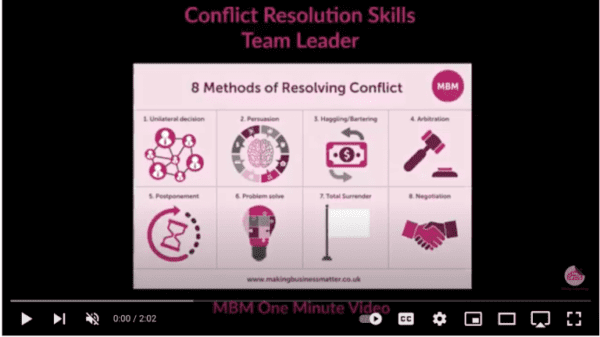
5th Stage – Adjourning
Bruce Tuckman added the fifth stage, Adjourning, around 1975. It’s also called Deforming and Mourning.
Characteristics
This is a break-up of the team; hopefully, after fulfilling its purpose. Members feel good about their achievements as they move on to new things.
Challenges
If team members bond, this change can give them a sense of insecurity. And that’s especially so for people with a strong routine and empathy style, based on the Herrmann Brain Dominance Instrument (HBDI).
10) Challenges to Team Building Skills
Effective team-building skills require an awareness of and preparation to deal with internal and external barriers. Some problems may be within your control, and you can change them. However, you’ll have to find creative ways to work around challenges beyond your control.
#1- Personality Differences
Trying to build a unified team, you’ll quickly find that people always behave differently regardless of what you do. Their behaviour is influenced mainly by how they prefer to think, which can be evaluated using the Herrmann Brain Dominance Instrument (HBDI).
HBDI or the ‘Whole Brain Model’ shows which areas we either prefer to think or not to think. It consists of a 120-question survey that produces a profile of your preferred thinking style. This conceptual representation presents basic thinking styles.
Take a look at our HBDI Infographic (you can click on it for a higher resolution):
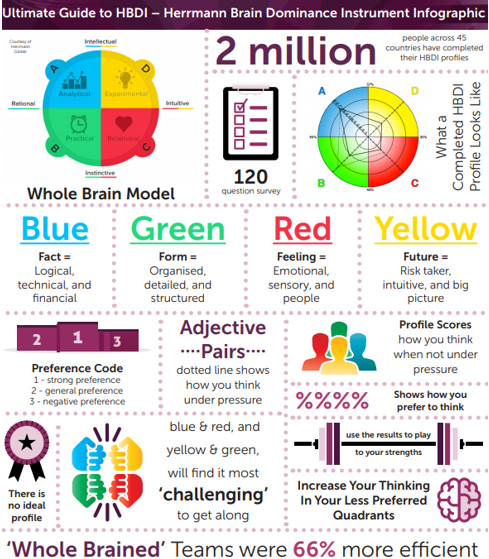
Understanding your team members’ thinking preferences will help you appreciate how they learn, solve problems, make decisions and communicate. You can then communicate in a way they appreciate and structure the team to suit their preferences.
You’ll also know, beforehand, areas of potential conflict arising from people who are less likely to get along. Diametrically opposed quadrants (blue (analytical) and red (relational), or yellow (experimental) and green (practical)) fall in this category.
For example, a practical person (green) might say, ‘We need a plan’. And an experimental person (yellow) would dismiss the person as being anal about detail. To deal with this, each member needs a role that suits their strengths. For instance, the experimental person might be great at coming up with creative ideas. Meanwhile, the practical person creates reliable plans.
#2- Lack of Team Building Teamwork Skills
Graduates coming from learning institutions often lack collaborative team-building skills, having been encouraged to work individually in college. Hence, you need more extensive team-building skills training to orient such employees to a team mindset.
#3- Virtual Workplaces
With increasing virtual workplaces, team members have fewer or even no physical meetings to build concrete relationships and trust. However, communication is still possible using robust technologies.
#4- Globalisation
Globalisation adds the challenge of different cultures, languages and values to building team skills. Hence, leaders must develop an in-depth understanding of the varied cultures, languages and values of their team members.
11) 8 Mistakes to Avoid

Mistakes can reduce or completely nullify the potential effectiveness of team building. You should be aware of the critical mistakes to avoid.
#1- Showing Your Preference
Team leaders shouldn’t show members that they have a preferred employee. Actually, such favouritism will discourage other members and make them lose motivation.
At ADT Corp, a company providing security services, sales reps perceived the preferential treatment of their managers compared to themselves. Glassdoor revealed that they felt treated more like secretaries than colleagues.
#2- Doing Most Tasks Yourself
A leader who doesn’t delegate is missing the whole point of building team skills. Only when you have a team that autonomously handles delegated tasks can you build a successful business.
#3- Accommodating Undisciplined Behaviour
Giving teams greater autonomy doesn’t also mean accommodating a lack of discipline. You must always discipline members who break the rules.
#4- Not Trusting Anyone
You build great teams on trust. Without it, it’s hard to collaborate. You’ll also have a closer rapport with team members if you trust them.
Dillard’s department store chain went public in 1969. However, the Dillard family didn’t let go of the management. And that is because the family did not trust anyone outside their bloodline to run the company. William T. Dillard founded the company in 1938 and, currently, four of CEO Bill Dillard II’s siblings are company executive officers. The senior vice president is the CEO’s son, William Dillard III.
Apparently, trusting others with managerial roles would have been a wise thing for the Dillard family. According to Glassdoor, workers are dissatisfied and decry poor management practices. Also, employees complained of frequently unrealistic sales quotas.
Inevitably, the firm ranked among the worst companies to work for. And for five consecutive years, it had a 2.6 job satisfaction rating on Glassdoor.
#5- Not Rewarding Performance
Incentives inspire better performance by team members. Hence, not rewarding your team for their achievement will stagnate or reduce their performance.
Poor pay and long hours at Dillard Stores are the main reasons only 36% of employees recommended the company to friends. This also affects the team’s perception of its leader, with only 38% approving of the CEO.
Obviously, you cannot overestimate the negative impact of not rewarding your workers adequately.
#6- Not Acting on Members’ Suggestions
Acting on members’ suggestions gives them a sense of ownership and belonging. Also, the opposite will happen if you don’t work on their recommendations. Furthermore, the worst thing you can do is make members look foolish for giving foolish suggestions.
#7- Neglecting Team Members’ Welfare
Kim Scott, in her book, Radical Candor, states that minding your employees’ welfare is part of being a boss. Members of your team want to feel that you value them more than just the work they do. And if you don’t mind about their welfare, they won’t develop a deep and lasting loyalty to the team.
Express Scripts, located in St. Louis, MO, is one company that neglected its employees’ welfare, according to Glassdoor. And even though employees enjoyed flexible hours, one-third cited poor pay and high pressure as the reasons why they wouldn’t recommend working for the company.
One Glassdoor review shows that ’employees are viewed as disposable’. Consequently, this is almost certain to affect workers’ motivation negatively.
#8- Allowing Unhealthy Competition
Lastly, unhealthy competition can easily disintegrate a successful team. So only encourage healthy competition among members.
12) Evaluating Team Building Skills Effectiveness
During and after your team-building events, you should assess the effectiveness of the actions you take.
MBM’s competency framework provides a clear template to evaluate the level of performance of your team. It will help assess whether your team is not delivering, in the early stages of delivering, showing some delivery, exhibiting a high level of delivery or fully delivering. Using the assessment, you’ll know what changes to make and improvements to apply.

Team Building Skills Training
Our Team Building Events will help you to achieve more as a team. For more information, please contact us. Our trainers are from your industry and they can provide training on any one of our products. Our work does not end with soft skill team-building as we have plenty more that we offer. That is, from Myers Briggs and GSCOP to Category Management, Time Management Skills and Presentation Skills, using our unique Sticky Learning methods.
13) Further Reading and Resources
Finally, you can find further insight, definitions and clarification of all the key terms mentioned in this guide in our Team Building Skills Glossary.
#1- Watch Our Videos

#2- Articles from Our Blog:
Take a look at our award-winning blog for more useful information and tips.
-
- A team leader is responsible for
- Participative management
- Global leadership
- Remote team building
- Belbin
- Team charters
- Why is Trust Important in Teams
- How to promote teamwork in the workplace
- Improve teamwork
- Boost team morale
- Virtual team icebreaker ideas
- Be the music for your team
- Managing Remote Teams
- High performing teams
#3- Contact Us
Feel free to get in touch to find out about how our team-building skills can help you. Simply visit our contact us page or email us at helpme@makingbusinessmatter.co.uk, and we will be happy to get back to you.




